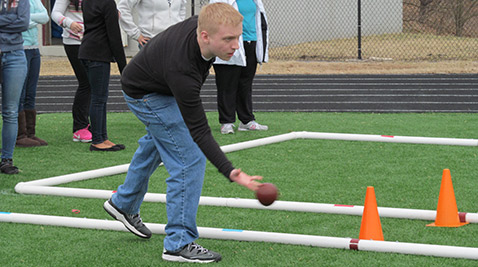ANNAPOLIS — Chris Patterson stood between two bocce courts during practice at Broadneck High School in Annapolis on a recent weekday, shouting encouragement to his teammates.
“Bend your knees!” the junior yelled to one player whose throw fell too short.
Patterson is a team captain of Broadneck’s unified bocce team. Six years ago, he wouldn’t have been able to even play.
Patterson is one of thousands of disabled students across the state of Maryland who are able to play high school sports thanks to the creation of unified or allied sports teams, which are made up of both students with disabilities and students without.
The unified sports scene in Maryland has grown sharply over the last few years, according to data from the National Federation of State High School Associations.
Between the 2011-12 and 2012-13 school years, the number of people on unified sports teams in Maryland more than doubled, jumping from 2,338 to 5,784, an increase of 147 percent. The growth was especially strong for female athletes on unified sports teams, which grew from 827 in 2011-12 to 2,739 in 2012-13, an increase of 231 percent.
The NFSHSA data counts the number of people participating in each sport, meaning that a single person who plays two sports would be counted twice.
The strong growth was driven by the addition of new unified and allied programs to Maryland high schools such as basketball, tennis, and track.
In 2008, the Maryland Fitness and Athletic Equity Act for Students with Disabilities was passed, ensuring that students with disabilities are provided equal opportunities to participate in athletic activities in Maryland schools.
Greg Baron, who is his fourth season coaching the unified bocce team at Broadneck, has seen the growth first-hand. He said he was overwhelmed by the number of students who came out for the team this year.
“This is the most we’ve ever had,” he said of the more than 40 students assembled at his practice. “It’s almost unmanageable. But it’s a great thing that it’s become so popular.”
Maryland is one of the leading states in the country for unified and allied sports teams, with several counties having leagues for sports like bocce, softball, bowling, and tennis.
Many schools, including Broadneck, have one unified team per season, meaning a disabled athlete could play sports the entire school year should they choose to play all three.
The Broadneck unified bocce team has gone to the Division I state championship three years in a row, which Baron figures is one of the reasons the sport has become so popular at the school.
“Going to state championships was really impressive, seeing how many counties in the state were involved and how many made their way out to Washington College to participate. It was something to see,” he said.
Patterson, who is also a member of the unified bowling team, has embraced his role as a team captain. He spent much of the team’s practice encouraging his teammates and overseeing the two bocce courts.
“It’s been really fun,” Patterson said of his experience with unified sports at the school. He said he’s made a lot of friends through the team.
The unified sports program also aims to integrate disabled students with non-disabled students in a way that might not normally occur. Baron said the non-disabled players on his team have always been very supportive.
“We have really great kids at this school, always very helpful with our kids with disabilities. Always willing to help out,” said Baron, who also coaches unified tennis at Broadneck.
Baron said he doesn’t know what the future of unified sports is in Maryland in terms of potential expansion to even more sports – especially as teams like his bocce one continue to have more and more students wanting to play – but he’s hoping to see the program continue to grow.
“I don’t know what the plans are. But I would definitely like to see that,” he said.

